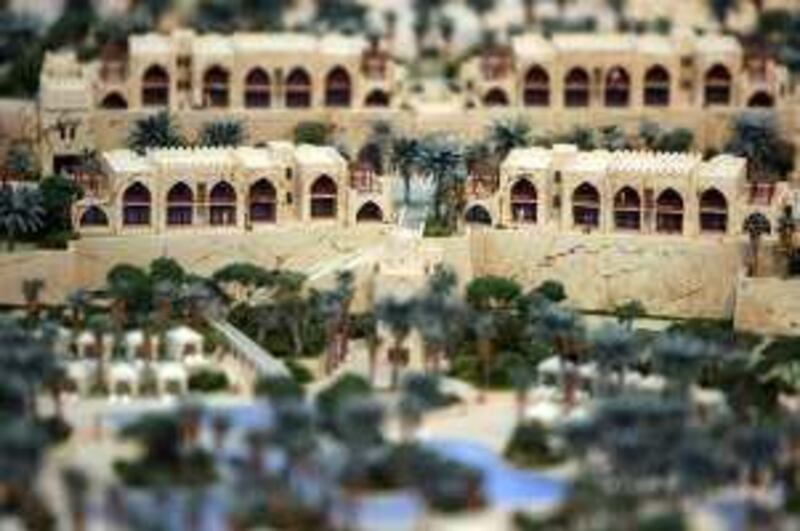The road to the Western Region is long; the view, a featureless, austere landscape. Containing the country's highest sand dunes and richest oil reserves, this area, now called Al Gharbia, remains one of the UAE's least developed areas. As such it offers a virtual blank canvas to the planning experts now in the process of putting together Plan Al Gharbia 2030, the document that will guide all development in the Western Region, ensuring it falls in line with the emirate-wide Plan Abu Dhabi 2030.
Launched in September 2007, the 2030 plan contains guidelines and a framework for all elements of urban development, to which every new building project must adhere. In the case of Al Gharbia, its authors must tread a fine line - allowing residents the opportunity to enjoy the benefits of a thriving modern existence while preserving the natural wonders that define the region. Held in November, the first Plan Al Gharbia 2030 brainstorming workshop established a preliminary framework, which will be presented to the Crown Prince later this month, after which a series of public consultations will take place in the region.
The Abu Dhabi Urban Planning Council (UPC), the Western Region Development Council (WRDC) and the Western Region Municipality are among the bodies drawing up the plan. Adnoc also plays a significant role in its creation, employing a large proportion of working Al Gharbia residents. The national oil company declined to comment for this story. A 60,000 square kilometre area, the Western Region possesses fragile coral reefs and other natural areas including the Sir Bani Yas nature reserve and the Liwa Oasis.
Mohammed Ebrahim al Hosani, acting director of regional development at the WRDC, said one of the greatest challenges in creating the Al Gharbia 2030 plan would be achieving a balance between preserving ecological integrity and intense urbanisation. "The area is so huge and the potential in Al Gharbia for the power industry, oil and gas, energy and tourism is so high," he said. "But we also have the reserved natural areas, a critical zone; the [Al Gharbia 2030] plan won't limit the development that can happen there, but it will have to guide it."
Some of the most recent developments in the region have been tourist destinations, namely Sir Bani Yas Island and Qasr Al Sarab - a five-star desert retreat conceived by the Abu Dhabi Tourism Development and Investment Company. Mr al Hosani said tourism would be an important element of the development plans but that basic infrastructure needs would have to be met first. "We need community services and infrastructure on an urgent basis," he said. "The plan will outline the criteria for all the development, not just technical, financial and environmental, but also social, cultural criteria."
Falah al Ahbabi, general manager of the UPC, said Al Gharbia's development process would be slower than in the rest of the country. The scale of developments will be lower than in Abu Dhabi or even Al Ain, with mostly low-density projects. "Right now, they lack everything. There's nothing there," he said. "Development there will be different than in Abu Dhabi because there is a different urban fabric, but there is also a rich culture that we will respect."
Like every area in the country, Al Gharbia's culture is unique, Mr al Ahbabi said. One of the main goals with the Al Gharbia 2030 is to maintain this rich culture and modernise in such a way that residents are not alienated by their new surroundings. The public consultation process should help achieve this, he said. Another major goal is to keep people living in the Western Region. Since the 1980s, Al Gharbia has been victim of significant migration out of the region to the urban centres.
Lack of educational and professional opportunities as well as insufficient basic services such as health care has made the Western Region an unappealing place to live. Over the past seven years, about one in five people born in Al Gharbia has left, according to the development council. Most of these were young people seeking jobs or education. Traditionally, few private sector jobs have been available in the region.The population is only around 120,000, a number authorities hope to increase as the development process gets underway. By 2017, they hope to attract about a million visitors each year.
Its designers say the Plan Al Gharbia 2030 will encourage public-private partnerships and outsourcing of services to reinvigorate the local economy and increase the quality of life for residents. Job creation will focus on the construction, oil and gas and agriculture industries as well as on public administration and affordable tourism - operative word being affordable. Bucking the national trend of building one luxury tourism destination after another, Al Gharbia authorities want to establish the area less as an exclusively high-end destination and emphasise its natural assets. Plans are also in place to market Al Gharbia as a destination for UAE residents' second homes. Rather than speeding up the slower pace of life in the Western Region, this characteristic will be marketed as one of the advantages of life in this part of the emirate.
Quality of life, Mr al Hosani said, is the ultimate goal the Plan Al Gharbia 2030 needs to achieve. "We are analysing the situation in Al Gharbia against the vision we have for its future. We want to attract and retain talent. "We want people to live where they work. We want to raise the quality of life. "We want to respect the nature and culture of place and keep Al Gharbia as a special region."
jhume@thenational.ae






